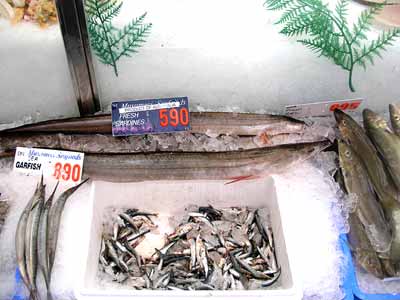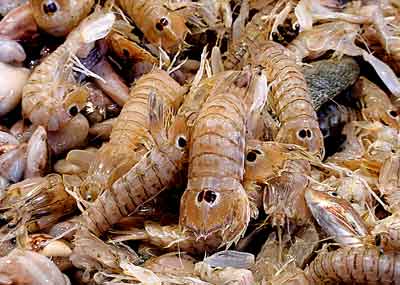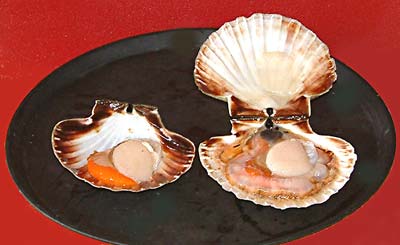
Conger eel, sea eel. The crustaceans and fish which form its diet contribute to its own good flavour. It is usually sold in steaks. It has few bones and good firm flesh with excellent flavour. The neck end has a better ratio of flesh to bone so is better for cooking as steaks, whereas the tail end, which is bonier, makes a useful addition to soups and stocks.

Mantis shrimp. Squill. A flat tailed crustacean with a delicate flavour found from the eastern coast of North America to the Adriatic and Mediterranean. It is related to a crab rather than a prawn and bears some resemblance to a praying mantis, a kind of flat lobster which makes a chirp like a cricket and has lilac marks on its white flesh.
"Ox tongue." Beefsteak mushroom. It may be sliced and fried like liver, or eaten raw with a salad, when it should be cut into thin strips, soaked in salted water, drained and then dressed with a vinaigrette.

Pilgrim or great scallop. These are shellfish with white meats and pink corals, often cooked in their shells with the corals and have sweet, succulent meat if properly cooked. According to legend, the body of St James (St-Jacques) travelled with a boat with neither oars nor sails around the Iberian coast, coming to rest in Compostela. Many miracles were associated with this journey, including one where the horse of a pagan nobleman leaped into the sea. They emerged carrying the body of St James covered in scallop shells. This resulted in the nobleman converting to Christianity. Pilgrims to Santiago de Compostela have traditionally worn scallop shell badges in commemoration of St James, or used scallop shells as begging bowls. The whole pilgrim route is decorated with his emblem. In some parts of Europe they are eaten on the feast day of St James on 25 July to commemorate the arrival of pilgrims or peregrinos at Santiago de Compostela, often with tomatoes and garlic. They are more often simply and lightly fried.